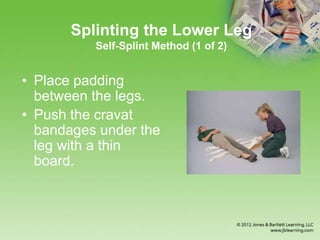This document provides guidance on splinting various extremities for injuries. It describes the reasons for splinting, types of splints including rigid, soft, and self-splints. Instructions are given for applying splints to the upper arm, forearm, wrist, hand, fingers, pelvis, hip, femur, knee, lower leg, and ankle. Slings are also described for supporting injured arms. The goal of splinting is to stabilize injuries, reduce pain, prevent further damage, and allow for safe transport to medical care.


















































